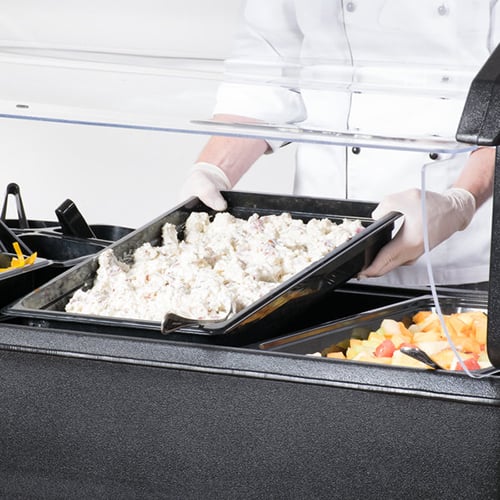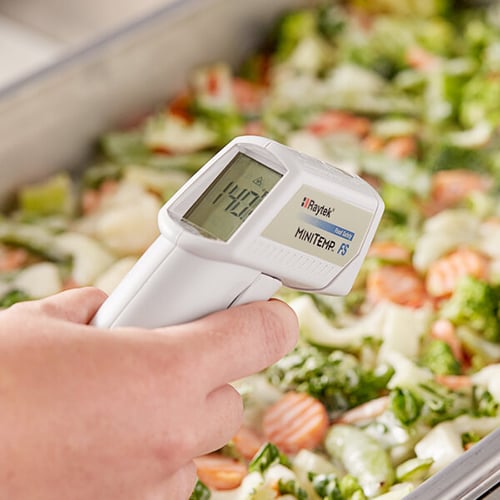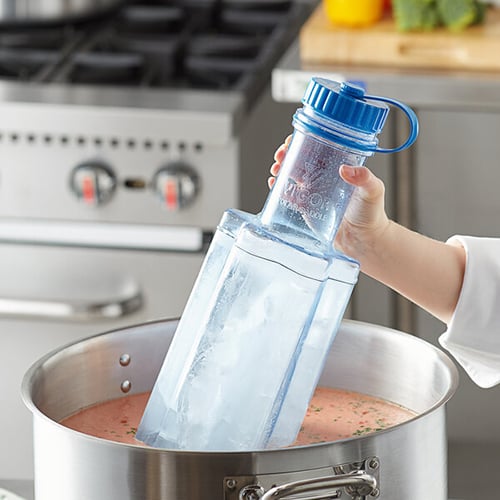For high-risk foods to remain safe for consumption, cold holding is a crucial process in any restaurant.
Pathogens can quickly multiply in the temperature danger zone for food, spoiling food within the first two hours.
A comprehensive article on food internal temperature. How to measure food’s internal temperature, why it’s crucial, how to calibrate a thermometer
Making sure that you reach the recommended internal pork temperature for safety is a crucial step in any recipe for pork. Undercooked pork has the potential.
What Is the Danger Zone for Food?
The temperature range known as the “danger zone” promotes the growth of bacteria in food. This danger zone for food temperatures is defined by ServSafe as being between 5 and 57 degrees Celsius and 41 to 135 degrees Fahrenheit. Between 70 and 125 degrees Fahrenheit, bacteria grow and multiply the fastest. The likelihood that bacteria will grow increases the longer food is left in the temperature danger zone.
Why Is the Temperature Danger Zone Important?
When foods are allowed to reach the danger zone for temperature, bacteria may develop unhealthily and lead to food spoilage. This type of dangerous bacterial growth may occur without any obvious indications that the food is unsafe to eat. Foods could have a pleasant smell and a normal appearance but still contain dangerous amounts of bacteria that cause foodborne illness.
This is what makes the temp danger zone extremely important. Use approved techniques to chill, heat, and store food as a food service professional to keep food out of the danger zone.
What Is Time Temperature Abuse?
Allowing food to remain in the danger zone of 41 to 135 degrees Fahrenheit is known as time temperature abuse. Abuse of time and temperature is a serious violation of the health code because it frequently causes foodborne illness in addition to cross-contamination. Foods may become time-temperature abused in three ways:
- Foods are not held or stored at food safe temperatures
- Food is not prepared or heated to the temperature necessary to destroy potential pathogens.
- Before being put in cold storage, hot food is not properly cooled down.
What Are TCS Foods?

TCS stands for time/temperature control safety. TCS foods are those that have strict time and temperature requirements. TCS foods are a favorite of pathogens as they provide an ideal environment for bacteria to flourish and spread. A crucial food safety practice is preventing TCS foods from entering the danger zone and from being time-temperature abused. The following TCS foods pose a high risk and need to be constantly under close observation:
- Milk and dairy products
- Meat and poultry
- Fish, shellfish, and crustaceans
- Shell eggs
- Baked potatoes
- Cooked rice, beans, and vegetables
- Tofu, soy protein, or other plant-based meat alternatives
- Sprouts and sprout seeds
- Cut tomatoes, melons, and leafy greens
- Untreated garlic and oil mixtures
How Long Can Food Stay in the Temperature Danger Zone?
According to ServSafe, the maximum amount of time ready-to-eat foods can be left in the temperature danger zone is 4 hours. Foods are deemed spoiled and must be thrown away after the 4-hour window. Foods can be consumed, reheated, or chilled to return to food-safe temperatures within the 4-hour time limit. Temperature checks every two hours give you more time to take any necessary corrective actions.
How to Keep Food Out of the Danger Zone
Kitchen thermometers are essential for preventing foods from reaching dangerous temperatures. You can stop food from being time-temperature abused by routinely monitoring and recording food temperatures. This is crucial when preparing, preparing, and holding food on your salad bar or buffet line.
Utilize your kitchen thermometers to the fullest extent possible in order to keep your food safe to eat.
- Always use the right type of thermometer for the job.
- Never rely on the temperature display of your equipment alone.
- As an added precaution, place a thermometer inside your freezer or refrigerator.
- Maintain written records of all temperature checks, including the temperature, the time, and the operator’s name.
- Clean and calibrate thermometers often.
To keep your menu items out of the danger zone, make sure that your staff members have received HACCP training and are familiar with these temperature logging procedures.

Before serving, it’s crucial to maintain these safe temperatures once your food has reached the proper internal temperature or has been chilled to 40 degrees Fahrenheit or lower. There are several situations where foodservice workers must hold food for a long time. These scenarios might involve holding food in buffet lines and salad bars, moving food to off-site locations, and catering events.
In order to ensure that your hot or cold foods stay safe for consumption while being transported, it is advised that you use a food pan carrier or an insulated catering bag.
For TCS foods, the cold food holding temperature must be 40 degrees Fahrenheit or lower. Here are some guidelines for holding cold foods safely so they don’t enter the danger zone:
- Assure that your cold-holding appliances, such as cold food tables and cold crocks, maintain food temperatures of 40 degrees Fahrenheit or lower.
- After being taken out of refrigeration at a temperature of 40 degrees Fahrenheit or lower, any cold food held without refrigeration is safe for up to 6 hours.
- Every two hours, check the temperature of cold foods, and throw away any that get to a temperature of at least 70 degrees Fahrenheit.
How Cold Does a Salad Bar or Refrigerator Have to Be to Keep Food Safe?
To stop the growth of harmful bacteria, salad bars and refrigerators must maintain temperatures of 40 degrees Fahrenheit or lower. This is crucial given that you store TCS foods like cheese, yogurt, meats, salad dressings, and egg products that are susceptible to contamination.
Hot food should be held at a temperature of 135 degrees Fahrenheit or higher. Here are some pointers for keeping hot foods out of harm’s way:
- Never use hot holding equipment to reheat food. Foods should be heated to safe temperatures prior to holding. Hot holding equipment, such as steam tables and holding cabinets, is made to maintain current temperatures rather than to raise the temperature of food.
- Keep food covered whenever you can to help regulate temperatures and keep contaminants out.
- Stir frequently to distribute heat throughout the food.
- Use the appropriate thermometer to monitor food temperatures often.
- Food that has been sitting above 135 degrees for more than four hours should be discarded.
- To avoid cross-contamination, never combine freshly prepared food with food that is already being held for service.
How Often Should I Check the Temperature of Hot or Cold Holding Food?
Every four hours, it is advised that you check the temperature of any food that is being held hot or cold. Instead, if you check every two hours, you’ll have enough time to react if any food has entered the danger zone. Simply reheating or refrigerating the contaminated foods will stop the spread of harmful bacteria and prevent food waste if you keep an eye on your food’s internal temperatures.
The following are some of the most typical inquiries about the danger zone in your kitchen:
Proper Cooling of Foods

It must be properly cooled before being stored in cold storage if food is being prepared in advance. It is crucial to swiftly lower the temperature through the danger zone after your menu item reaches the ideal internal temperature. Food should be cooled to 70 degrees Fahrenheit in two hours, and then to 41 degrees Fahrenheit in four hours.
Although it may seem like the simplest solution, it is never advised to put hot food directly into your refrigerator or freezer because doing so raises the temperature of the surrounding food and puts it at risk. This increases the chance that other foods in your refrigerator or freezer will reach a dangerous temperature and grow bacteria without your knowledge. Instead, follow these tips for quickly cooling your hot foods.
- Utilize a commercial blast chiller to rapidly cool food and reduce the amount of time it is exposed to danger.
- Foods should be kept in shallow containers to help the temperature spread more evenly.
- To lower the temperature of hot liquids like soups, stews, and sauces, think about using a cooling paddle.
- Fill a pot, container, or sink basin with ice to make an ice bath. The ice bath can be used to quickly cool containers of hot food to 40 degrees Fahrenheit or lower.
How to Thaw Food
Inadequately defrosting food is one of the most prevalent instances of time temperature abuse in a kitchen. It may be tempting to run food under hot water to thaw it or leave it out on the counter to thaw it, but doing either of these puts your food at risk of getting into the danger zone. Use the following methods to defrost food safely:
- Prior to cooking, place the frozen food in the refrigerator for 10 to 24 hours.
- Put the frozen food in a spotless prep sink and run cold water over it.
- Use the defrost setting on a microwave.
- Cook from frozen, regularly checking internal temperatures.
You’ll also want to ensure that your foods have reached safe internal temperatures for at least 15 seconds before serving in addition to worries about the danger zone. A temperature guide for some of the most popular ingredients can be found below.
- Poultry, stuffing, and any dish that contains a cooked TCS food should be cooked to 165 degrees Fahrenheit.
- Eggs from the shell, ground meat, and meats with flavorings should all be cooked to 155 degrees Fahrenheit.
- Seafood, steaks and chops, game meat, and roast meats should all be cooked to 145 degrees Fahrenheit.
- Cook to 135 degrees Fahrenheit: Fruits, vegetables, grains, legumes
The safety of the food being served is the top priority for all food service providers. By implementing these crucial suggestions and obtaining food handling certification for your staff, you can guarantee that they have the skills necessary to keep food out of danger zones, respond to errors, and safeguard clients from foodborne illnesses.
Join Our Mailing List
Receive coupon codes and more right to your inbox.Email Address
Get our latest deals and more.
Tips, guides, & advice
© 2023 The WEBstaurant Store, LLC – All Rights Reserved. Variation ID:
Cooking 101: Proper cooking Temperatures to Ensure Safe Food – White Apron Catering, Lake Worth, Fl
FAQ
What is the proper cold holding temperature for fresh beef?
Foods kept in cold storage must always be kept at or below 41°F. Foods that are considered to be in the “Danger Zone” must be discarded. Throw away food if it reaches the “Danger Zone” in temperature. At these temperatures, germs multiply quickly, making food unsafe to consume.
What is the cold holding temperature for deli meat?
Cold Food. Foods should be kept at 41 degrees Fahrenheit or lower, and the temperature should be checked every four hours. Food must be thrown away if it reaches a temperature of more than 41 degrees Fahrenheit after four hours.
